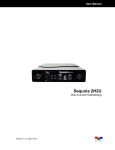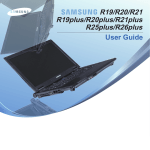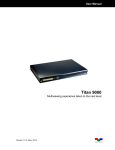Download User`s Manual (EN) - Avitech International Corporation
Transcript
User Manual Titan 8000 Visual Command Center Revision 1.0.0, (February, 2014) User Manual ABOUT THIS MANUAL This manual contains information on how to use Avitech proprietary Phoenix-G (formerly Galaxy) software to configure the Titan 8000. Throughout the manual the following conventions are used to distinguish elements of text. provides additional hints or information that requires special attention. identifies warnings which must be strictly followed. Any name of a menu, command, icon or button displayed on the screen is shown in a bold typeset. For example: On the Start menu select Settings. To assist us in making improvements to this user manual, we would welcome any comments and constructive criticism. Email us at: [email protected]. WARNING Do not attempt to disassemble the Titan 8000. Doing so may void the warranty. There are no serviceable parts inside. Please refer all servicing to qualified personnel. TRADEMARKS All brand and product names are trademarks or registered trademarks of their respective companies. COPYRIGHT The information in this manual is subject to change without prior notice. No part of this document may be reproduced or transmitted in any form or by any means, electronic or mechanical for any purpose, without the express written permission of Avitech International Corporation. Avitech International Corporation may have patents, patent applications, trademarks, copyrights or other intellectual property rights covering the subject matter in this document. Except as expressly written by Avitech International Corporation, the furnishing of this document does not provide any license to patents, trademarks, copyrights or other intellectual property of Avitech International Corporation or any of its affiliates. TECHNICAL SUPPORT For any questions regarding the information provided in this guide, call our technical support help line at 425-885-3863, or our toll free help line at 1-877-AVI-TECH, or email us at: [email protected] ii Contents About This Manual .................................................................................................................... ii Technical Support ..................................................................................................................... ii Warranty..................................................................................................................................... v Limitation of Liability ................................................................................................................ v Extended Warranty Options..................................................................................................... v Services and Repairs Outside the Warranty Period .............................................................. v Regulatory Information ............................................................................................................ v Federal Communications Commission (FCC) Statement ..................................................... v European Union CE Marking and Compliance Notices ........................................................ v Australia and New Zealand C-Tick Marking and Compliance Notice .................................. v 1. Phoenix-G Configuration ............................................................................................ 1 1.1 Connection Method ........................................................................................................... 1 1.2 Pinging the Titan 8000....................................................................................................... 1 1.2.1 Method 1 ................................................................................................................. 1 1.2.2 Method 2 ................................................................................................................. 1 1.3 Starting Up the Phoenix-G Software ................................................................................ 2 2. Basic Setup Using the Phoenix-G Software .............................................................. 5 2.1 Group Layout Menu ........................................................................................................... 5 2.2 Module Layout Menu ......................................................................................................... 6 2.3 Select Menu ........................................................................................................................ 6 2.4 Settings Menu .................................................................................................................... 6 2.4.1 Setting the Desired Output Resolution ............................................................... 8 2.4 System Parameter Menu ................................................................................................. 13 2.5 Group Parameter Menu ................................................................................................... 19 2.6 Module Parameter Menu ................................................................................................. 30 2.7 Special Screen Layout Menu .......................................................................................... 35 2.8 Help Menu ......................................................................................................................... 36 2.9 Quick Keys – Change Window to/from Full Screen Mode; Swap Window Contents 42 2.10 Window Layout ................................................................................................................ 43 2.10.1 Setting the Default Layout (by Group) ............................................................. 43 2.10.2 Arranging Windows (by Group) ........................................................................ 43 2.11 Mouse Right-click Menu.................................................................................................. 44 2.11.1 Resizing Window ................................................................................................ 45 2.11.2 Automatic VGA Signal Adjustment .................................................................. 46 2.11.3 Apply Manual Image Settings (Position / Source Type and Gain) ................ 46 2.11.4 Manual Image Settings ...................................................................................... 46 2.11.5 Signal Type/Format ............................................................................................ 52 2.11.6 Setting Label Properties .................................................................................... 53 iii 2.11.7 Setting Border Properties .................................................................................. 54 2.11.8 Setting Alarm ...................................................................................................... 55 2.11.9 Check Signal ....................................................................................................... 56 2.11.10 Quick Cropping an Image on a Window .......................................................... 56 2.11.11 Specifying the Size of a Cropped Image .......................................................... 56 2.11.12 Restore ................................................................................................................ 57 2.11.13 Pan Image............................................................................................................ 58 2.11.14 Aspect Auto Detect ............................................................................................ 59 2.12 Turn On/Off Window/Label ............................................................................................. 60 2.13 Saving to a Flash File ...................................................................................................... 60 2.14 Saving a Preset ................................................................................................................ 62 2.15 Loading File ...................................................................................................................... 63 2.16 Making Adjustments ........................................................................................................ 65 2.17 Control Video Fade .......................................................................................................... 67 Appendix A Setting Up Static IP .................................................................................. 68 A.1 Method 1: Change IP Address of Titan 8000 Master Chassis ..................................... 68 A.2 Method 2: Change IP Address of the Controlling Computer ...................................... 69 For Windows XP .............................................................................................................. 69 For Windows 7 ................................................................................................................. 69 Appendix B Setting Up COM Port ................................................................................ 71 iv Warranty Regulatory Information Avitech International Corporation (herein after referred to as “Avitech”) warrants to the original purchaser of the products manufactured in its facility (the “Product”), that these products will be free from defects in material and workmanship for a period of 1 year or 15 months from the date of shipment of the Product to the purchaser. There is a 3 month grace period between shipping and installation. Marking labels located on the exterior of the device indicate the regulations that the model complies with. Please check the marking labels on the device and refer to the corresponding statements in this chapter. Some notices apply to specific models only. Federal Communications Commission (FCC) Statement This equipment has been tested and found to comply with the limits for a Class A digital device, pursuant to Part 15 of the FCC Rules. These limits are designed to provide reasonable protection against harmful interference when the equipment is operated in a commercial environment. This equipment generates, uses, and can radiate radio frequency energy and, if not installed and used in accordance with the instruction manual, may cause harmful interference to radio communications. Operation of this equipment in a residential area is likely to cause harmful interference, in which case the user will be required to correct the interference at his own expense. Properly shielded and grounded cables and connectors must be used in order to meet FCC emission limits. Avitech is not responsible for any radio or television interference caused by using other than recommended cables and connectors or by unauthorized changes or modifications to this equipment. Unauthorized changes or modifications could void the user's authority to operate the equipment. Operation is subject to the following two conditions: (1) this device may not cause harmful interference, and (2) this device must accept any interference received, including interference that may cause undesired operation. If the Product proves to be defective during the 1 year warranty period, the purchaser’s exclusive remedy and Avitech’s sole obligation under this warranty is expressly limited, at Avitech’s sole option, to: (a) repairing the defective Product without charge for parts and labor; or (b) providing a replacement in exchange for the defective Product; or (c) if after a reasonable time is unable to correct the defect or provide a replacement Product in good working order, then the purchaser shall be entitled to recover damages subject to the limitation of liability set forth below. Limitation of Liability Avitech’s liability under this warranty shall not exceed the purchase price paid for the defective product. In no event shall Avitech be liable for any incidental, special, or consequential damages, including without limitation, loss of profits for any breach of this warranty. If Avitech replaces the defective Product with a replacement Product as provided under the terms of this Warranty, in no event will the term of the warranty on the replacement Product exceed the number of months remaining on the warranty covering the defective Product. Equipment manufactured by other suppliers and supplied by Avitech carries the respective manufacturer’s warranty. Avitech assumes no warranty responsibility either expressed or implied for equipment manufactured by others and supplied by Avitech. European Union CE Marking and Compliance Notices Statements of Compliance English This product follows the provisions of the European Directive 1999/5/EC. Dansk (Danish) This Warranty is in lieu of all other warranties expressed or implied, including without limitation, any implied warranty of merchantability or fitness for a particular purpose, all of which are expressly disclaimed. Dette produkt er i overensstemmelse med det europæiske direktiv 1999/5/EC. Nederlands (Dutch) Dit product is in navolging van de bepalingen van Europees Directief 1999/5/EC. This Hardware Warranty shall not apply to any defect, failure, or damage: (a) caused by improper use of the Product or inadequate maintenance and care of the Product; (b) resulting from attempts by other than Avitech representatives to install, repair, or service the Product; (c) caused by installation of the Product in a hostile operating environment or connection of the Product to incompatible equipment; or (d) caused by the modification of the Product or integration with other products when the effect of such modification or integration increases the time or difficulties of servicing the Product. Suomi (Finnish) Tämä tuote noudattaa EU-direktiivin 1999/5/EC määräyksiä. Français (French) Ce produit est conforme aux exigences de la Directive Européenne 1999/5/EC. Deutsch (German) Dieses Produkt entspricht den Bestimmungen der Europäischen Richtlinie 1999/5/EC. Any Product which fails under conditions other than those specifically covered by the Hardware Warranty, will be repaired at the price of parts and labor in effect at the time of repair. Such repairs are warranted for a period of 90 days from date of reshipment to customer. Ελληνικά (Greek) To προϊόν αυτό πληροί τις προβλέψεις της Ευρωπαϊκής Οδηγίας 1999/5/EC. Íslenska (Icelandic) Þessi vara stenst reglugerð Evrópska Efnahags Bandalagsins númer 1999/5/EC. Extended Warranty Options Avitech offers OPTIONAL Extended Warranty plans that provide continuous coverage for the Product after the expiration of the Warranty Period. Contact an Avitech sales representative for details on the options that are available for the Avitech equipment. Italiano (Italian) Questo prodotto è conforme alla Direttiva Europea 1999/5/EC. Norsk (Norwegian) Dette produktet er i henhold til bestemmelsene i det europeiske direktivet 1999/5/EC. Services and Repairs Outside the Warranty Period Avitech makes its best offer to repair a product that is outside the warranty period, provided the product has not reached its end of life (EOL). The minimum charge for such repair excluding shipping and handling is $200 (US dollars). Português (Portuguese) Este produto cumpre com as normas da Diretiva Européia 1999/5/EC. Español (Spanish) Este producto cumple con las normas del Directivo Europeo 1999/5/EC. AVITECH INTERNATIONAL CORPORATION ● 8655 154th Ave., NE Redmond, WA 98052 ● TOLL FREE 1 877 AVITECH ● PHONE 1 425 885 3863 ● FAX 1 425 885 4726 ● [email protected] ● http://avitechvideo.com Svenska (Swedish) Denna produkt har tillverkats i enlighet med EG-direktiv 1999/5/EC. Australia and New Zealand C-Tick Marking and Compliance Notice Statement of Compliance This product complies with Australia and New Zealand's standards for radio interference. v 1. Phoenix-G Configuration The Avitech Phoenix-G program (formerly Galaxy) requires no installation. Just copy the system files to your computer’s hard drive. This chapter introduces the Phoenix-G software for setting up the Titan 8000. Make sure the Titan 8000 is powered on and connected properly to your computer through Ethernet before launching the Phoenix-G software. 1.1 Connection Method Connect your Titan 8000 to the controlling computer through an Ethernet (IP address) cable or serial cable (see Appendix B for details on connecting through RS-232). Before connecting the computer to the Titan 8000, the computer with DHCP LAN connection will need to be changed to static IP, similar range as the Titan 8000 (e.g., ”210.100.100.151” – factory-default setting). Or, change the IP address of the Titan 8000 to a similar range as the controlling computer. See Appendix A for details. 1.2 Pinging the Titan 8000 Make sure you can ping the chassis at “210.100.100.151” (factory-default IP address). 1.2.1 Method 1 Step 1. Click StartAll ProgramsAccessoriesCommand Prompt. The Command Prompt screen will appear. Step 2. Type “ping 210.100.100.151” and press Enter. Step 3. Type “exit” to exit the Command Prompt screen. 1.2.2 Method 2 Step 1. Run the Phoenix-G software by double-clicking Phoenix-G.exe. Click Others. Figure 1-1 Click “Others” 1 Step 2. Click to select the Others radio button, and on the Module Style drop-down menu select VCC-8000 (Titan). Select IP (make sure the IP address matches the chassis’) and then click Ping to verify. Figure 1-2 Select “Others” Set “Module Style” and “IP” Click “Ping” Step 3. Click OK. Figure 1-3 Pinging Test is Successful 1.3 Starting Up the Phoenix-G Software Step 1. Run the Phoenix-G software by double-clicking Phoenix-G.exe. Under IP select User Define if you know the IP address assigned to the Titan 8000 or select Automatically Search. Click OK. Figure 1-4 Set Communication Mode 1. 2. If you have 2 or more modules cascaded, they should also be detected. Make sure that the slave module’s baud rate and resolution is the same as the master module’s. 2 Step 2. The computer will start searching for Titan and confirm connection. Click OK. OR Figure 1-5 Configuration Report (Standalone or Cascaded Setup) Make sure the cascaded modules have different rotary ID settings (e.g., 1 – 2 – 3) on their rear panels. Phoenix-G “Module Layout,” “Control” and “Option” window will appear. “Module Layout” window contains the bird’s eye view of the module layout belonging to each ID in the system. In this example, the left window displays the layout belonging to ID:1 on the Phoenix-G (former Galaxy) control window; while the right window displays the layout belonging to ID:2. “Control” window is for creating and configuring the layout. Logo icon Avitech Phoenix-G (former Galaxy): proprietary logo and name of software. 1024×768 (60Hz): shows the output resolution and frequency of the monitor. Baud: 57600 bps shows the baud rate setting. “Option” window is for video window/label setup; save/load file; adjust image; window size/ position setting, fader control, and COM A setup. Figure 1-6 Module Layout, Control and Option Window 3 When entering the Phoenix-G software for the first time, the layout for ID: 2 may be covered by ID: 1. 4 2. Basic Setup Using the Phoenix-G Software This chapter introduces you to the Phoenix-G (formerly Galaxy) software for setting the features of your Titan 8000; as well as familiarizes you with the menus appearing on the Phoenix-G software. Some items appearing on the menus of the Phoenix-G software may not be available (grayed-out). 2.1 Group Layout Menu Right-click the title bar to access the Group Layout menu. Select from 2×2 up to 8×8 as possible grid positions on the monitor. 1. The layout size available for your particular model will depend on the monitor’s resolution as well as the smallest window size limitation (Titan smallest window size is 144×128 pixels). 2. An 8×8 grid position is possible when the OSD (on screen display) and label are turned off. Figure 2-1 “Group Layout” Menu Upon enlarging/shrinking or changing the position of a particular window inside the Phoenix-G control window, a 1 / 2-pixel gap may be seen afterwards between the particular window and its neighboring windows appearing on the monitor output. This is normal due to the difference in resolution setting of monitor running the Phoenix-G program vis-à-vis the resolution setting of the monitor output. It is most noticeable when the overall Phoenix-G control window is small. 5 2.2 Module Layout Menu Select from 2×2 up to 4×4 (LeftRight or TopBottom) as possible grid positions. Figure 2-2 “Layout” Menu 2.3 Select Menu Figure 2-3 “Select” Menu Step 1. Click Open Option Menu to toggle on/off the Option window. Step 2. Click Dock Option Menu to return the Option window to its default position on the right side of the Phoenix-G control window. This option is not available (grayed-out) if the previous item Open Option Menu is disabled (without checkmark). 2.4 Settings Menu Figure 2-4 “Settings” Menu By default the Titan will automatically detect the optimum display resolution so Set Output Mode will be grayed-out (disabled). When using the Titan for the first time or upon setting the device to its factorydefault setting, automatic detection of optimum display resolution will occur only on the device that is connected to the monitor. The rest of the cascaded device will still retain their factory-default setting. Use the Phoenix-G software to disable this feature by performing the following steps: 6 For an individual module – Step 1. Click Settings then Module Parameter. Figure 2-5 “Settings””Module Parameter” Step 2. Click Auto Parameter. Then click to unselect (remove the checkmark) the Detect Display Resolution option. Figure 2-6 ”Auto Parameter””Detect Display Resolution” For a group – Step 1. Click Settings then Group Parameter. Figure 2-7 “Settings””Group Parameter” 7 Step 2. Click Auto ParameterDetect Display ResolutionOff. Figure 2-8 ”Auto Parameter””Detect Display Resolution” 1. When the monitor is unable to provide the EDID signal it will display at 1024×768 / 60Hz. The extended display identification data (EDID) is a data structure provided by a computer display to describe its capabilities to a graphics card. 2. When the Detect Display Resolution option is selected (with checkmark) all the presets will be displayed in the optimum resolution. Likewise, when the Detect Display Resolution option is not selected (without checkmark) and you have set the desired resolution using the Set Output Mode all the presets will be displayed in the desired resolution that you have set. 2.4.1 Setting the Desired Output Resolution Changing the output resolution affects all the modules in the selected group. If you have more than one group, make sure you select the correct Group on the drop-down menu. Figure 2-9 Option Panel: Set “Group” 8 Step 1. Click Settings and then click Set Output Mode. Figure 2-10 “Settings””Set Output Mode” When the Detect Display Resolution option is “on” the Set Output Mode function is not available (grayed-out). Step 2. Set the output resolution to match the monitor’s resolution. Select the Refresh Frequency, select the Mode and then click OK. You will notice that the selected resolution is displayed on the title bar of Phoenix-G software. Figure 2-11 Select ”Refresh Frequency” and “Mode” 1. When the output resolution is set at 1360×768 / 1400×1050 / 1680×1050 and the display is set at the default 2×2 layout, misalignment will occur due to the software’s automatic scaling feature. This is because a window on the monitor increases/decreases by increments of 16 pixels horizontally, and the midpoint of the 1360×768 / 1400×1050 / 1680×1050 resolution is not divisible by 16 pixels. Oftentimes this also causes the rightmost portion of the monitor to have a 16 pixel black curtain. 2. Upon changing the output resolution the output windows appearing on the monitor may overlap or in the case of fixed window layout (e.g., 2×2, 3×3, 4×4, etc.) misalignment may occur. Choose a new window layout to fix this. 9 When the Flashing Window Border option is enabled (with checkmark) the border of the window where the mouse cursor just resided will blink twice to notify you of its location. Figure 2-12 “Settings””Flashing Window Border” When you have unplugged the IP cable and re-connected it, click Reconnect (Network) to continue the configuration process. Or, when using the serial cable, click Reconnect (COM Port) instead. Figure 2-13 “Settings””Reconnect (Network) / (COM Port)” 10 ® Import/Export (.txt) allows you to import a label from / export label to Microsoft Office Word or Notepad to be edited externally. Figure 2-14 “Settings””Import/Export (.txt)” Step 1. The most convenient way is to export the file (label) as a BMP Label (Unicode) or Label (ANSI) “txt” file by assigning a filename. Figure 2-15 Export Label as Text File 1. The UB 1601 firmware version “0t” does not support the BMP Label function, only version “g0” supports the BMP Label function. To find out the UB 1601 firmware version, go to HelpRead BIOS Version. The middle portion of the highlighted text string should read “g0”. 2. UB 1601 firmware version “0t” cannot be changed to version “g0” and vice versa (hardware limitation). Figure 2-16 Display BIOS Version 11 Step 2. Edit the text in the file, starting with Group 1 and Module 1. When you are done editing the label (highlighted as shown below) save the “txt” file and import it. The on screen labels will be updated. Figure 2-17 Edit the Label Step 3. Click Export (.txt) to export all firmware/hardware information to a text file and assign filename. Figure 2-18 Export Information as Text File Step 4. Click Save. The next screen shows the text file opened using Notepad. Figure 2-19 Sample Firmware/Hardware Information Text File 12 2.4 System Parameter Menu Figure 2-20 “System Parameter” Menu Return Group Index to Default allows you to return all groups to their default setting, as well as combine all modules into one group. Click OK to complete the configuration change. Figure 2-21 System Parameter: “Return Group Index to Default” One Module Per Group By default, the Phoenix-G software will combine all available modules into one large group. To quickly divide modules into different groups, each module can be treated as a group. For example, if cascading 4 modules, it will divide into 4 groups. Click OK to finalize the changes. The configuration progress is shown. Figure 2-22 System Parameter: “One Module Per Group” Figure 2-23 System Parameter: Progress of Configuration 13 An alternative method for creating a new group is: Step 1. Right-click the module you wish to add to the new group. Then click Set ID# toNew Group. Figure 2-24 Option Panel: “Set ID# to””New Group” Step 2. Repeat for all additional modules (you can either add additional modules to the new group or create additional groups). Step 3. To switch between the different groups, use the Group drop-down menu. Figure 2-25 Option Panel: Switch ”Group” Step 4. Exit the Phoenix-G software and select Yes when prompted to save to flash memory. 14 Save System Files to Flash allows you to save all configuration settings to flash memory. If the system configuration has been changed, save the changes first before continuing the other configuration settings. The progress of saving to flash memory will be displayed. Figure 2-26 System Parameter: Save System Files to Flash To turn on/off All Labels/Clocks for all the modules, regardless of the group it belongs to, click ON/OFF. Figure 2-27 System Parameter: Turn On/Off All Labels/Clocks Module Cascade Series Do not use this function when the Titan is connected to the Avitech MKC-104 / -204 (mouse/keyboard controller). Figure 2-28 System Parameter: DVI Switch Use the DVI Switch function to enable or disable Cascade In for each ID number. Use the Cascade Series function to change the ID number designation only; this will not affect the actual physical connection of the Titan. 15 Make sure the ID number designation on the Cascade Series section must match the actual physical connection of the cascaded Titan. Example DVI output of last module of each group is feeding the monitor. VGA output of the last module of each group is also connected to the background input of the first module of the other group. During normal operation the input of the first module of each group is disabled (switched to default black background). Figure 2-29 DVI Output of Last Module of Each Group Feeds the Monitor VGA Output of Last Module of Each Group is Connected to Background Input of First Module of Other Group The following setting is shown to affect the above sample scenario. Take note that the Circular Mode item must be enabled. Figure 2-30 Module Cascade Series: Enable “Circular Mode” 16 In case one monitor fails, a preset combining all the inputs of both groups can be recalled through the looping cable. In case the other monitor fails, another preset addressing this situation can be recalled. The same concept can be extended to more than 2 groups. Figure 2-31 Module Cascade Series: Monitor Failure Illustration The following setting is shown to affect the above sample scenario. Figure 2-32 Module Cascade Series: Setting for Monitor Failure Figure 2-33 System Parameter: Advanced Step 1. Use Broadcast Load File is for loading presets / switching resolution / group reset. When this option is enabled (with checkmark) the Phoenix-G software will broadcast the command allowing for simultaneous execution of the command. This feature should always be enabled. 17 Step 2. When Automatically Backup Files to Hard Drive is enabled (with checkmark) the Phoenix-G software will save all backup files to the computer hard drive’s “c:\Avitech_VCC\Backup\” folder. You may change this by clicking Browse to select a different location to save the backup information. Step 3. When the window is unable to detect a signal, No Signal Size Refer to will serve as the basis for the Phoenix-G software to adjust the window size. NTSC: maximum window size is 816×465. PAL: maximum window size is 816×560. When running tally via RS-232, use Clear Tally Status to close it. Alternatively, use the ASCII Z command to close tally via RS-232. You need to connect your Titan to the MKC-104 / -204 (mouse/keyboard controller module) for MKC Properties to take effect. Figure 2-34 “MKC Properties” Step 1. The Active Window Border feature allows you to set the border color of the active window. Each pixel/line can be set to have a different color; all lines can be set to be the same color (All Lines) by clicking the radio button to select the Line #. Then click Select color to choose the color. There are 8 options for choosing the 3D border. Click the radio button for one of the 3D borders to select it. Step 2. To swap the 2 mouse buttons so that you can use the right button as the left button, click the checkbox to enable Switch primary and secondary buttons. 18 Step 3. If the item Transfer control to this remote computer is enabled (with checkmark) – keyboard/ mouse control will transfer to the particular window (computer) that has just entered full screen mode. Default setting is disabled (keyboard/mouse control does not transfer to a particular computer that enters full screen mode). Step 4. Click the radio button for Remain full screen when pressing Pause/Break key under the item When returning from full screen to host mode if you wish to remain in full screen mode upon pressing the Pause/Break key. Default setting is Return to previous layout upon pressing Pause/Break key. Step 5. When the item Swap with active window is enabled (with checkmark) – the action of entering a computer window (other than the current active window) will cause both active and newly entered windows to swap position. Default setting is enabled for this item. Step 6. Click Select Color to change the background color of the pop-up selections. Step 7. Then click OK when finished and exit the MKC Properties window. The Phoenix-G software still retains the settings until the next time you change the settings in the MKC Properties window or you return the system to the factory-default state. 2.5 Group Parameter Menu Figure 2-35 “Group Parameter” Menu 19 Group Reset allows you to refresh all modules belonging to the same group. 2 hierarchies for setting the Label properties are available: one can affect the entire group, while the other affects a single window. For an Entire Group 1. Select SettingsGroup ParameterLabel to adjust the Font Color, B-G (background) Color, and font Size for all labels in the group. 2. Make sure to turn on all labels (see previous section) before setting the label properties. Figure 2-36 Group Parameter: Label Properties (Group) For an Individual Window Step 1. Right-click a window and select Label to enter text. Figure 2-37 Group Parameter: Label Properties (Individual Window) 20 Each window supports one line of text, up to 30 characters. Figure 2-38 Group Parameter: Enter Label (up to 30 Characters) Step 2. BMP Label: allows you to activate universal fonts for labels by performing the following steps: 1. Click to enable the BMP Label checkbox (with checkmark). 2. Click the BMP Label Font Type button. 3. When the Font window appears, set the Font, Font style, and Size. Then click OK. 4. On the Line 1 window enter a label in the desired language by first selecting the language on the Windows taskbar. 5. Repeat the above steps for all the other windows. 1. The UB 1601 firmware version “0t” does not support the BMP Label function, only version “g0” supports the BMP Label function. To find out the UB 1601 firmware version, go to HelpRead BIOS Version. The middle portion of the highlighted text string should read “g0”. 2. UB 1601 firmware version “0t” cannot be changed to version “g0” and vice versa (hardware limitation). Figure 2-39 Display BIOS Version 21 Borders are turned on by default. To turn off the border perform the following steps. For an Entire Group 1. Select SettingsGroup ParameterBorder, and then change the Border Width to 0. 2. You can also change the border color. Each pixel/line can have a different color. 3. 3D border. Figure 2-40 Group Parameter: Border Properties (Group) For an Individual Window Right-click the window and select Border, and then select the desired color and size. Figure 2-41 Group Parameter: Border Properties (Individual Window) 22 Tally RJ-50-to-GPI terminal block allows for a total of 8 inputs to activate tally, 2 per window. You can also use the serial port with ASCII, TSI, or TSL to activate tally. To change the appearance of tally, select SettingsGroup ParameterTally. Tally 1 is triggered by GPI. Settings that can be adjusted include Tally Color, LED, Label, Border, and Flash. Figure 2-42 Group Parameter: Tally Properties 23 Set Alarm allows you to setup the notification when a signal is missing. For an Entire Group Click Alarm. Then click Module Alarm Switch to set the Process / Video Alarm Switch for alarms in the group and Response Time (Second) when No Video occurs. Figure 2-43 Group Parameter: Alarm Properties (Group) 24 For an Individual Window Right-click the window and select Set Alarm. Module/Process Alarm Switch: turn on alarm setting by enabling both options (with checkmark). Video Alarm Switch: turn on/off the “no video” signal. Response Time (Second): set the “no video” alarm response time from 0 to 23 seconds. Figure 2-44 Group Parameter: Alarm Properties (Individual Window) 1. 2. Clock Make sure to turn on all clocks (see previous section) before setting the clock properties. Select SettingsGroup ParameterClock to adjust the Font Color, B-G (background) Color, and font Size for all clocks in the group. You can also set the Border, Hide Clock (Full screen mode), Count (UP / DOWN), Source, and Time Zone. Figure 2-45 Group Parameter: Clock Properties (Group) 25 To activate the time code feature, on the Source portion click to select Free Run. Then click the Update button (on the lower right portion) and then click OK. The NTP time code feature allows the Titan to synchronize the clock with an external NTP time server. The IP port on the rear of the Titan can control, as well as receive, time code information simultaneously. When cascading the Titan modules, each module’s IP port must detect the NTP time code with an external NTP time server individually (no synchronization feature). To set up the NTP time code, do the following: Step 1. Make sure that CountUp is selected. Figure 2-46 Group Parameter: Clock Properties (Group) Step 2. On the Source portion click NTP to select it. Then click the NTP Properties button. Step 3. Enter the IP address of the NTP Server, the default Gateway (use “ipconfig” in Windows DOS mode to find out), then set the update frequency time interval. Figure 2-47 Group Parameter: NTP Properties 26 Step 4. Select the Time Zone in the drop-down menu and click the Daylight checkbox to select DST (daylight saving time) when applicable. Step 5. Click Update (on the lower middle portion) and then the OK button. You may be required to exit the Phoenix-G (Galaxy) software by first saving the new settings to flash memory, and then restarting the Phoenix-G (Galaxy) software before the clock can be updated. COM A allows you to configure the serial port of the module with the computer for configuration and control. To set the COM port, perform the following steps (by default, the COM port is set to normal, and the baud rate is set to 57600 bps): Step 1. On the Option window, click Set COM A. Figure 2-48 Group Parameter: NTP Properties Step 2. Select the Setting COM A option (if applicable). Set the Baud Rate. Select the Mode (Normal – for use with ASCII or TSI Load File – for use with the SCP (Simplified Control Panel) keypad). Figure 2-49 Group Parameter: NTP Properties 27 Step 3. After setting COM A, you will be prompted to close the Phoenix-G software and power cycle (shutdown and restart) the module. Aspect Auto Detect allows you to turn on/off automatic detection of the input signal’s aspect ratio. For HD-SDI input signal, the aspect ratio will be 16:9; for SD-SDI / NTSC/PAL, aspect ratio default setting is 4:3. Figure 2-50 Group Parameter: Aspect Auto Detect There are 2 Output Timings namely Normal and VESA. Normal output timing is designed for some brands of monitors that do not support the VESA standard. The default setting for output timing is Normal. Figure 2-51 Group Parameter: Output Timing VGA to Background allows you to alter the sequence of a particular cascading window that appears on the monitor. By default Window 1 should appear on top of Window 2 but you can move it to be behind Window 2 into the background. This item may not be available when displaying HDCP-compliant content. Window Size 3 sizes are available for displaying all the windows in a group: 4:3, 16:9, or Lock Aspect Ratio. When changing the width of the window, the height will automatically adjust to match the aspect ratio. When Lock Aspect Ratio is set to On, the aspect ratio of the video display will be maintained, even if the window is stretched. If the image is 4:3 and it is stretched to 16:9, the result is 2 vertical black bars appearing on either side of the display. If the image is 16:9 and it is scaled down to 4:3, then it will have a letterbox effect. Figure 2-52 Group Parameter: Window Size 28 Auto Parameter Titan 8000 can automatically detect a particular group display’s optimum resolution. To enable or disable this feature, perform the following steps: Step 1. Click Auto Parameter. Step 2. Select On/Off in Detect Display Resolution. When the Detect Display Resolution option is set to On, all the presets will be displayed in the optimum resolution. Figure 2-53 Group Parameter: Auto Parameter HDCP Detection When set On, allows Titan 8000 to detect if the connected monitor is HDCP-compliant as well as turn off VGA signal output via the DVI-I Out port. When set Off, Titan 8000 is unable to detect if the connected monitor is HDCP-compliant but will allow output of VGA signal via the DVI-I Out port. Figure 2-54 Group Parameter: HDCP Detection Set Default Layout When you have multiple units cascaded together, you can quickly show all the windows by selecting SettingsGroup ParameterSet Default Layout. 29 2.6 Module Parameter Menu Figure 2-55 “Module Parameter” Menu Change to an IP Address different from the default one. Figure 2-56 Module Parameter: IP Address 30 After entering the desired values click OK. Click OK again to confirm. Figure 2-57 Module Parameter: Change IP Address Successful Titan 8000 can automatically detect a particular module display’s optimum resolution. Click Auto Parameter and click Detect Display Resolution to enable this feature (with checkmark). Figure 2-58 Module Parameter: Auto Parameter 2 types of Output Timings are available: Normal and VESA. Normal output timing is designed for some brands of monitors that do not support the VESA standard. The default setting for output timing is Normal. Figure 2-59 Module Parameter: Output Timing Clock Window When item All Clocks under System Parameter is set On, a checkmark appears on this item. You can turn on (with checkmark) or off clock window display. Click the item to toggle between on/off. RJ-50-to-GPI terminal block allows for a total of 8 inputs to activate Tally, 2 per window. You can also use the serial port with ASCII, TSI, or TSL to activate tally. Select SettingsModule ParameterTally. Tally 1 is triggered by GPI. Settings that can be enabled include Tally Color, LED, Label, Border, and Flash. Figure 2-60 Module Parameter: Tally 31 1. When VGA to Background under Group Parameter is set On, a checkmark appears on this item. This allows you to alter the sequence of a particular cascading window that appears on the monitor. By default Window 1 should appear on top of Window 2 but you can move it to be behind Window 2 into the background. Click the item to toggle between on/off. 2. This item may not be available when displaying HDCP-compliant content. GPI Definitions 8 positions can be found on the RJ-50-to-GPI terminal block that are assignable to either activate tally (one per video input), load presets, or trigger a clock event (pin 2, 4, 6, 8); but each pin can only be assigned one task. Assign the definition of each GPI and click OK to finalize the changes. Figure 2-61 Module Parameter: GPI Definitions 1. By default, the terminal block is used to turn on/off the tally for each window: – Position 1 + GND = turns on main tally for window 1. – Position 2 + GND = turns on main tally for window 2. – Position 3 + GND = turns on main tally for window 3. – Position 4 + GND = turns on main tally for window 4. – Position 5 + GND = turns on main tally for window 5. – Position 6 + GND = turns on main tally for window 6. – Position 7 + GND = turns on main tally for window 7. – Position 8 + GND = turns on main tally for window 8. 2. Make sure that the RJ-50 GPI terminal block is inserted into the GPI port on the rear panel. Based on your requirement, connect wires from the switcher unit to the 8 pins on the terminal block. Then connect to the ground pin. 32 Set the Preset Time (1 – 8), for counting up or down, that can be recalled using GPI. Figure 2-62 Module Parameter: Preset Time VCC OSD allows you to turn on (with checkmark) or off your Titan 8000 OSD (on screen display) feature. Click the item to toggle between on/off. Apply Manual Image Settings (Position / Source Type and Gain) allows you to turn on (with checkmark) or off your Titan 8000 automatic detection of DVI/VGA input signal. Based on the settings stored in EEPROM, it will adjust the position and size, set DVI signal source type, and adjust the coloring of VGA image (intensity). This feature is most useful when restarting the Titan 8000 or when unplugging and plugging the DVI/VGA cable. Click the item to toggle between on/off. Line Lock was designed for the PELCO video camera CCC1380UH-6 and it only supports the PAL/NTSC video source. Process 2 corresponds to the Video 1 connector, Process 4 corresponds to the Video 2 connector, Process 6 corresponds to the Video 3 connector, and Process 8 corresponds to the Video 4 connector on the rear of the Titan 8000. Figure 2-63 Module Parameter: Line Lock 33 VCC8000 BMP Label Resource allows you to allocate the BMP Label Resources for the 8 (Titan 8000) windows. Window 1 and Window 2 are processed by the first 1601 IC (integrated circuit) chip. Window 3 and Window 4 are processed by the second 1601 IC chip. Window 5 and Window 6 are processed by the third 1601 IC chip. Window 7 and Window 8 are processed by the fourth 1601 IC chip. When a window (e.g., Window 1) is enabled (with checkmark) and the other window (e.g., Window 2) is disabled (no checkmark), the resource allocation for the first window will be 100 % and for the other window is 0 %. When both windows (e.g., Window 3 and Window 4) are enabled (with checkmark), the resource will be evenly allocated (50 %). When both windows (e.g., Window 3 and Window 4) are disabled (no checkmark), the resource will still be evenly allocated (50 %). No simultaneous zero resource allocation (0 %) for both windows can occur. Figure 2-64 Module Parameter: BMP Label Resources 1. When a Window’s BMP Label Resource is zero (0 %), the checkbox will be disabled (grayed-out). 2. For Titan 8002V and Titan 8004V no BMP Label Resource allocation is required. The resource allocation for both models is 100 %. 3. UB 1601 firmware version “0t” does not support the BMP Label function, only version “g0” supports the BMP Label function. To find out the UB 1601 firmware version, go to HelpRead BIOS Version. The middle portion of the highlighted text string should read “g0”. 4. UB 1601 firmware with version “0t” cannot be changed to version “g0” and vice versa (hardware limit). Figure 2-65 Module Parameter: Tally When HDCP Detection under Group Parameter is set On, a checkmark appears on this item. 34 2.7 Special Screen Layout Menu Figure 2-66 “Special Screen Layout” Menu Some special screen layouts are available for the Titan (layouts that are grayed-out signify nonavailability for your particular configuration): Layout 1 (Default 2×2) – quad split mode Layout 6 (Briefing) – cycle between presets for a slideshow effect Figure 2-67 “Briefing” Window 35 2.8 Help Menu Figure 2-68 “Help” Menu To Read the Avitech Titan 8000’s BIOS Version, perform the following steps: Step 1. Click Help and then click Read BIOS Version. Figure 2-69 “Help” Menu “Read BIOS Version” Step 2. Click Export. Figure 2-70 “Display BIOS Version” Window 36 Step 3. Assign a filename and click Save to save the data. Figure 2-71 “Export All Information” Window To update signal type/format, click Update Signal Type/Format and the image’s signal type/format will be shown. Figure 2-72 “Signal Type/Format” Window To backup a preset, perform the following steps: Step 1. Click Help and then click Backup All Information. Figure 2-73 “Help” Menu “Backup All Information” Step 2. Click OK to continue. Figure 2-74 Old Information Deletion Confirmation 37 Step 3. When backup is successful, click OK to continue. This will backup all saved presets and system configuration files to your computer hard drive’s “c:\Avitech_VCC\Backup\IPxxx.xxx.xxx.xxx\xxxx#_#” or “c:\Avitech_VCC\Backup\COM_1\xxxx#_#” folder. Figure 2-75 Backup Successful Everything in the Backup folder will be erased. If you have previously backed up presets, they will all be written over when you backup presets again. If you want to keep the old presets, move the entire Backup folder to a temporary directory (e.g., c:\temp). Restore Module Information To manually restore a preset perform the following steps: Step 1. Set the Titan 8000 to the factory-default value. Make sure that the rotary ID of the Titan 8000 being restored matches the old module (if the same module is not being restored), and that the form of communication is the same (IP or RS-232). Step 2. If the backup content is somewhere else other than at the “c:\Avitech_VCC\Backup\IPxxx.xxx.xxx.xxx\xxxx#_#” or “c:\Avitech_VCC\Backup\COM_1\xxxx#_#”, copy the backup data “xxxx#_#” into the “c:\Avitech_VCC\Backup\IPxxx.xxx.xxx.xxx\” or “c:\Avitech_VCC\Backup\COM_1\” location. Step 3. Run the Phoenix-G software and select Yes when prompted whether to restore the module using the backup data. Figure 2-76 Restore Module Using Backup Data Step 4. Click Help and then click Restore Module Information. You should see a progress bar showing the preset being loaded into the Titan 8000. Figure 2-77 “Help” Menu “Restore Module Information” 38 Step 5. The checking result confirms that everything is normal. If that is the case, click Cancel to exit restoring of preset(s). You may skip steps 6 and 7. Figure 2-78 ”Check Module Information” Window (All Normal) Click to enable the Forces checkbox (located on the upper right corner) that allows the backup information to be written to all the module(s) flash memory. The Restore button will then be enabled so you can click it. If the checking result shows an Abnormal report, confirm if the backup Path is correct. Then click Restore. Figure 2-79 ”Check Module Information” Window (Abnormal Information) The progress of the restore process will be shown. Figure 2-80 Progress of Restore Process 39 If the backup Path is incorrect, click Browse to select correct location. Then click OK. Figure 2-81 Select Directory Step 6. Click OK. Figure 2-82 Restore Window Step 7. Click OK to restart the Phoenix-G software. Figure 2-83 Restart Phoenix-G If upon clicking Restore Module Information on the Help menu and the error message appears click OK. Figure 2-84 Module Information Not Found 40 Click Browse. Figure 2-85 Click “Browse” Click Browse again to specify the correct backup Path. Figure 2-86 Specify Correct Backup Path To save Preset file to ASCII, perform the following steps: Step 1. Click Help, and then click Preset to ASCII. Figure 2-87 “Help” Menu “Preset to ASCII” 41 Step 2. Confirm if the Save Path is correct. If incorrect, click Browse to select the correct location. Figure 2-88 Confirm Save Path Step 3. Select the Requirements, and then click Conversion. Step 4. Click OK to exit. To find out the Phoenix-G software version, click Help and then click About. Figure 2-89 Version Information 2.9 Quick Keys – Change Window to/from Full Screen Mode; Swap Window Contents Two quick keys are available to quickly bring a window to/from full screen mode as well as swap the contents from one window to another by performing the following steps: Step 1. To change to / return from full screen mode, double-click the window. Step 2. To access the swap window quick key move your cursor to the bottom left hand corner of a window until a capital letter S appears. Figure 2-90 Swap Window Quick Key 42 Step 3. Click the capital letter S to select the source window and then click again at a destination window where you want to swap the contents from the source. This will swap all the contents and properties of the source window to the destination window. 2.10 Window Layout 2.10.1 Setting the Default Layout (by Group) When you have multiple units cascaded together, you can quickly show all the windows by selecting SettingsGroup ParameterSet Default Layout. 2.10.2 Arranging Windows (by Group) To quickly setup the layout for your video windows, right-click the title bar to access the Group Layout menu. Select from 2×2 up to 6×6 as possible grid positions on the monitor. The layout size available for your particular module will depend on the monitor’s resolution as well as the smallest window size limitation. Figure 2-91 “Group Layout” Menu 43 To reposition a window, drag the center of a window and drop to a new position and it will update on the monitor. Or, use Position Fine Adjustment menu to adjust position of any window on a pixel by pixel basis. Keep in mind that the width increases in 16 pixel increments and the height in 1 pixel increments. Figure 2-92 “Position Fine Adjustment” Window 2.11 Mouse Right-click Menu To change the properties of an individual window, right-click the particular window to access the window’s menu. Figure 2-93 Window Right-click Menu 44 2.11.1 Resizing Window To resize a single window to one of the preset sizes perform the following steps: Step 1. Right-click a particular window and select Size followed by the desired preset size selection. Figure 2-94 “Size” Menu Step 2. Alternatively, resize a window by dragging the border of a window to the desired size. Keep in mind that there is a scaling limitation for each window that limits the maximum scalable size to 816×465 pixels for NTSC video and 816×560 for PAL video. Step 3. Another option is to use the Size Fine Adjustment menu to adjust each window on a pixel by pixel basis. Keep in mind that the width increases in 16 pixel increments and the height in 1 pixel increments. Figure 2-95 “Size Fine Adjustment” Window Step 4. On a particular window select Full Screen to maximize the image and fill up the whole screen. You can click the desired window button to switch windows in full screen mode. 45 Step 5. If desired, select Full screen (to back) (with checkmark) to allow window (image) in full screen mode to appear in the background. Select Full screen (to back) (without checkmark) to allow the window (image) in full screen mode to reappear in the foreground (fill up the whole screen). Full Screen (to back) may not be available when displaying HDCP-compliant content. 2.11.2 Automatic VGA Signal Adjustment When using a VGA signal with the Computer/YPbPr 1 – 4 on the Titan 8000, there will be times when the image is not aligned in the window or the color is off, the VGA Auto Setting feature was designed to overcome these issues. Right-click the Computer/YPbPr 1 – 4 window, click VGA Auto Setting, and then select Auto Image Adjustment to align the VGA image inside the window, Auto Gain to correct the color values, or Export Settings to export the configuration settings as INI files. Figure 2-96 Right-click Window “VGA Auto Setting” Some VGA-to-DVI signal cables may not work with the Computer/YPbPr 1 – 4 / DVI-I Cascade / DVI-I Out ports of the Titan 8000, use the proprietary VGA-to-DVI adapter instead. 2.11.3 Apply Manual Image Settings (Position / Source Type and Gain) Turn on (with checkmark) or off correction of DVI/VGA input signal. Based on your settings stored in EEPROM or in the next item Manual Image Setting (if any), it will adjust the position and size, set DVI signal source type, and adjust the coloring of VGA image (intensity). This feature is most useful when restarting the Titan 8000 or when unplugging and plugging the DVI/VGA signal cable. Click the items to toggle on/off. 2.11.4 Manual Image Settings After plugging in the VGA/DVI signal cable to the Computer/YPbPr 1 / 2 / 3 / 4 port (use the DVI-to-VGA adapter when connecting the VGA signal cable), Titan will automatically perform Auto Image Adjustment and Auto Gain. The sample display below shows the image is still off-centered (does not completely fill the upper and left portion). Figure 2-97 Sample Off-Center Image 46 To use the Manual Image Setting feature to correct this problem, perform the following steps: Step 1. Make sure the previous 2 items Apply Manual Image Settings (Position / Source Type and Gain) are enabled (with checkmark). Step 2. Right-click the VGA/DVI input source window. Figure 2-98 Right-click Window “Manual Image Setting” Step 3. Click Manual Image Setting. Figure 2-99 DVI/VGA Adjustment Step 4. (For DVI input signal source only) Specify if the DVI signal Source Type is RGB or YUV. 47 Step 5. Use the slider to adjust the value of H_Start, V_Start, and H_Total. Continue the adjustment until the image has completely filled up the entire window. H_Start: use the slider to increase the value. The window will start moving towards the left, the dark portion will be reduced. Continue the adjustment until the image is aligned horizontally. V_Start: use the slider to increase the value. The window will start moving upwards, the dark portion will be reduced. Continue the adjustment until the image is aligned vertically. 1. 2. Make sure that the values of H_Start plus Width must not exceed H_Total. The value of V_Total based on the values of V_Start plus Height must not exceed the value automatically computed (by the software) based on the input signal’s pre-determined value for V_Total. If not, the following error message will appear. Figure 2-100 Error in Value of “V_Total” Step 6. (For VGA signal input source only) Change the Gain’s value if necessary. The next sample figure shows the window that has been adjusted properly. Figure 2-101 Sample Adjusted Image 48 Step 7. Select if the adjustments are to be applied to the particular window only (Computer Port #), All Computer Port (Module), All Computer Port (Group), or All Computer Port (System). Figure 2-102 Select the Adjustment Destination Step 8. Click Save to EEPROM to save the new adjustments in EEPROM. 1. EEPROM can store up to 56 sets of DVI/VGA signal’s Visible Scope and VGA signal’s Gain parameters. 2. When using the Phoenix-G software to command “gm1601” to perform Auto Image Adjustment or Auto Gain, “gm1601” will not use the parameters stored in EEPROM. The purpose of this is so that when the user makes the wrong settings, you can use Auto Image Adjustment or Auto Gain to cause the DVI/VGA setting values to attain the nearest correct value, then use the Phoenix-G software’s Manual Image Setting function to do minor adjustments to attain the correct values. This will allow the user to adjust the DVI/VGA parameters quickly. 3. “gm1601” will not automatically save the DVI/VGA parameters to EEPROM. You must use the Phoenix-G software’s Manual Image Setting dialog box’s Save to EEPROM function. 4. Click Load from EEPROM to use Manual Image Setting values. Make sure Auto Image Adjustment and Auto Gain options are enabled. This allows the firmware to automatically use the saved parameters. 5. When using the DVI/VGA input source with the same resolution but with different display card, or when using the same display card but with different resolution, the image displayed on the screen may be off-center (misaligned). In this case, perform the necessary settings and save configurations to EEPROM. Step 9. Click OK. Figure 2-103 Click “OK” to Save to EEPROM 49 Step 10. Click OK. Figure 2-104 Click “OK” 1. When the Auto Image Adjustment function is enabled, and upon restarting Titan 8000, or unplugging/ plugging the DVI/VGA cable, or change in DVI/VGA signal, “gm1601” will perform Auto Image Adjustment, and then look up the Visible Scope values stored in EEPROM. The values of the Visible Scope stored in “gm1601” will be used to adjust the DVI/VGA image. This function is used to fix the inability of the DVI/VGA image to fill up the entire window. 2. When the Auto Gain function is enabled, upon restarting Titan 8000, or unplugging/plugging the VGA cable, or change in VGA signal, “gm1601” will look up the Gain value stored in EEPROM. If the Gain value is found in “gm1601,” it will then adjust the ADC based on the Gain value found in EEPROM. If the Gain value is not found in EEPROM then “gm1601” will perform Auto Gain. This function can fix the image color problem (intensity) of the VGA signal coming from the computer. To extract the VGA/DVI modes stored in the EEPROM and burn-in these modes to all the new modules, perform the following steps: Step 1. Right-click the VGA/DVI input source window and click Manual Image Setting. Figure 2-104 Right-click Window “Manual Image Setting” 50 Step 2. Click Export to extract the VGA/DVI modes stored in the EEPROM. Figure 2-105 Click “Export” Step 3. Assign a filename and click Save to save the data. Figure 2-106 Assign a Filename and Click “Save” 51 Step 4. Click Save to EEPROM to save the new DVI/VGA/YPbPr input adjustment values and click Load from EEPROM to use the restore function (changes the VGA/DVI adjustment values to the previously saved values in EEPROM). Or click Clear EEPROM to return to the factorydefault values. Figure 2-107 “Load From / Save to / Clear EEPROM” 2.11.5 Signal Type/Format To check all input sources, click Help and then click Update Signal Type / Format. Figure 2-108 “Help””Update Signal Type / Format” 52 Figure 2-109 Windows Signal Type 2.11.6 Setting Label Properties Step 1. Right-click a window and select Label to enter the text. Keep in mind that each window supports one line of text (up to 30 characters). Figure 2-110 Windows Signal Type Step 2. BMP Label: allows you to activate the universal fonts for labels: 1. Click to enable the BMP Label checkbox (with checkmark). 2. Click the BMP Label Font Type button. 3. When the Font window appears, set the Font, Font style, and Size. Then click OK. 4. On the Line 1 window enter a label in the desired language by first selecting the language on the Windows taskbar. 5. Repeat the above steps for all the other windows. 53 1. 2. UB 1601 firmware version “0t” does not support the BMP Label function, only version “g0” supports the BMP Label function. To find out the UB 1601 firmware version, go to HelpRead BIOS Version. The middle portion of the highlighted text string should read “g0”. UB 1601 firmware with version “0t” cannot be changed to version “g0” and vice versa (hardware limitation). Figure 2-111 Display BIOS Version – “UB 1601” 2.11.7 Setting Border Properties Borders are turned on by default. To turn off the border, click Border and change the Border Width to 0. Figure 2-112 Turn Off Border Each pixel/line of border can have a different color. Figure 2-113 Set Pixel/Line Color of Border 54 3D border. Figure 2-114 Set 3D Border 2.11.8 Setting Alarm Upon right-clicking a particular window, select Set Alarm. Figure 2-115 Phoenix-G Software: “Alarm Properties – Process” Window Module/Process Alarm Switch: to turn on the alarm setting make sure that both options are enabled (with checkmark) Video Alarm Switch: to turn on/off the “no video” signal Response Time (Second): to set the “no video” alarm response time from 0 to 23 seconds 55 2.11.9 Check Signal To determine if the video signal is being fed into the selected window, right-click a particular window and click Check Signal. Figure 2-116 Right-click Window “Check Signal” One of the following screens may appear: Figure 2-117 DVI / SDI / VGA / YPbPr Signal Type Description 2.11.10 Quick Cropping an Image on a Window This allows you to crop (cut-out) an image on a particular window. Click Quick Crop Image Box Size to create a starting point and then drag to the desired location. Release the mouse to set the end point. A cropped out image of the former window will be created. The smallest allowed size of crop area is 96×80 pixels based on the module’s output resolution (not based on the “source” resolution). 2.11.11 Specifying the Size of a Cropped Image This allows you to set the specific size of the crop (cut-out) image on a particular window. Freely adjust the horizontal (Left and Right) and vertical (Top and Bottom) markers, or enter the numerical value to set the size of the cropped image. 56 You can also click the buttons to make smaller adjustments to the markers. Example 1: if the Titan’s output resolution is set at 1920×1200 but the input source resolution is 1920×1080, then pressing any of the 4 buttons on a 25 % magnification would effect a proportionally 4 pixel horizontal adjustment, while a 50 % or 100 % magnification would effect a proportionally 2 pixel horizontal adjustment. Example 2: if the Titan’s output resolution is set at 1024×768 but the input source resolution is 1920×1080, then pressing any of the 4 buttons on a 25 % magnification would effect a proportionally 6 pixel horizontal adjustment, while a 50 % or 100 % magnification would effect a proportionally 2 pixel horizontal adjustment. Then click Update. A cropped-out image of the former window will be created. Figure 2-118 Phoenix-G Software: “Setting Crop Size” Window 2.11.12 Restore This allows you to undo the previous cropping action and restore the image prior to cropping (1:1). Then adjust (enlarge) the window size manually by dragging on the sides/corners. 57 2.11.13 Pan Image Click Pan Image. This allows you to use the mouse (drag using the symbol) to pan (see the NOTE below for description of pan) the cropped image window (zoom in area). You can also click the X– / X+ / Y– / Y+ (x / y-axis coordinates, plus or minus) or H– / H+ / W– / W+ (height/width, plus or minus) buttons to make smaller adjustments. Figure 2-119 Phoenix-G Software: “Pan Region-of-Interest” Window To pan is to move the image around in the image window, usually when the image is larger than its window. Panning changes the image view in the same way that scrolling moves the image up, down, to the left, or to the right in the image window. When the entire image is not displayed you can quickly pan to see parts of the image that were previously hidden. 58 2.11.14 Aspect Auto Detect This allows you to set the input signal’s aspect ratio for a particular window. If the input signal is a different aspect ratio than the monitor in which it is displayed you may change the monitor’s aspect ratio to display the signal without deformation. Step 1. Right-click a particular window and click Aspect Auto Detect. Figure 2-120 Right-click Window “Aspect Auto Detect” Step 2. Select Enable and then select the desired aspect ratio. Figure 2-121 “Aspect Auto Detect” for Video Window (left) and Computer Window (right) 59 2.12 Turn On/Off Window/Label Step 1. The Option window has two checkboxes that can be used to close an image window (W) or turn off the label (L) for each window. Figure 2-122 “Option” Window (W and L) Step 2. To turn off a window or label find the checkbox that represents the selected window and check to enable or un-check to disable the Window or Label. 2.13 Saving to a Flash File There are 2 instances for which you will need to use the save to flash feature: After creating the master layout and you want the Titan to load it again when the unit is power cycled (shutdown and restart). After you are done saving presets and you want to save all the presets that were created into the internal flash memory of the Titan. If this action is skipped the Titan will lose all the presets that were created. 60 To save to flash memory perform the following steps: Step 1. Click Save File in the Option window. Figure 2-123 Click “Save File” in “Option” Window Step 2. Click Update to Module Flash and then click OK. Figure 2-124 “Save File” Window Alternatively, close the Phoenix-G software and select Yes when prompted to save. 61 2.14 Saving a Preset All the presets you create are stored in the Titan, not in the computer that is running the Phoenix-G software. In order to write all the presets into the internal flash memory of the Titan after creating it you will need to save to flash memory. To save a preset, perform the following steps: Step 1. Configure the layout you want the Titan to display. Step 2. Click Save File in the Option window. Step 3. Enter a unique filename for the preset and select OK to save. When using a keypad, use the numbers 0 – 9 for your preset names. When using the GPI, use the numbers 1 – 8 for your preset names. The file extension “GP#” will be automatically added to the file name. Figure 2-125 “Save File” Window Enter Unique Filename Step 4. Repeat the above steps for each additional preset. Step 5. After you are done creating presets load the file that you want to be the master layout which gets loaded when the module is powered on. Step 6. Close the Phoenix-G software and select Yes when prompted to save to flash. 62 2.15 Loading File Step 1. In the Option window click Load File. Figure 2-126 Click “Load File” in “Option” Window Step 2. Select a saved file and then click OK to load the preset. 63 Figure 2-127 Select the Preset File When saving your preset do not use the same filename as the system’s default preset filename (layout1.GP1 / layout2.GP1 / layout3.GP1). 64 2.16 Making Adjustments Step 1. In the Option window click Adjustment. Figure 2-128 Click “Adjustment” in “Option” Window 65 Step 2. Select the Image Window then adjust the input signal such as, Brightness (0 – 255), Saturation (0 – 255), Contrast (0 – 255), Hue (0 – 255), and Color Key Higher (All/Red/ Green/Blue, 0 – 255) parameters directly by using the sliders or clicking the radio button. Click the Default button on the lower right portion of the screen to reset the values to the factory-default. Figure 2-129 “Image Adjustment” Window The Color Key Higher parameter can only be adjusted when VGA to Background under Group / Module Parameter is turned off (without checkmark). 66 2.17 Control Video Fade This allows you to set the speed that an overlapping pair of windows will fade into the background when another pair of windows becomes the active window (Window 1 and Window 2, Window 3 and Window 4, Window 5 and Window 6, Window 7 and Window 8 are considered pairs). For Titan Window 1 and Window 2 or Window 3 and Window 4 or Window 5 and Window 6 or Window 7 and Window 8 will fade simultaneously. This is because Window 1 and Window 2 are both processed by the first 1601 IC (integrated circuit) chip, Window 3 and Window 4 are both processed by the second 1601 IC chip, Window 5 and Window 6 are both processed by the third 1601 IC chip, while Window 7 and Window 8 are both processed by the fourth 1601 IC chip. Step 1. In the Option window click Fader Control. Figure 2-130 Click “Fader Control” in “Option” Window Step 2. Adjust the Fading Speed directly by using the slider to select Slow (1) – Fast (10). Then click OK. Figure 2-131 “Fader Control” Window 67 Appendix A Setting Up Static IP The following two methods allow Titan 8000 to be in the same network mask with the connected computer. A.1 Method 1: Change IP Address of Titan 8000 Master Chassis Step 1. Run the Phoenix-G software by double-clicking Phoenix-G.exe. Click Others. Figure A-1 Phoenix-G Software: Click “Others” Step 2. Click to select the Others radio button, and on the Module Style drop-down menu select VCC-8000 (Titan). Method 1: Select COM 1 (must be the same as the COM port setting of your computer – refer to Appendix B for details). Method 2: Select IP (make sure the IP address matches the chassis’ – try to Ping it to verify). Then click Change IP Address. Figure A-2 Select “Others” Set “Module Style” and “COM” Port / “IP” Click “Change IP Address” 68 Step 3. Enter the new IP address, Subnet mask, and Gateway, to match the value of the controlling computer. Then, click OK. Figure A-3 Enter New “IP Address” “Subnet Mask” “Gateway” Step 4. Click OK. Click Cancel (to exit “Update BIOS” window) and then click Cancel again (to exit “Communications Mode” window). Figure A-4 Update IP Address Successful A.2 Method 2: Change IP Address of the Controlling Computer For Windows XP Step 1. Click Start, and then right-click My Network Places, and click Properties. Step 2. When the next screen appears, right-click the Local Area Connection icon, and click Properties. Step 3. When the next screen appears, click to highlight Internet Protocol (TCP/IP), and click Properties. Step 4. When the next screen appears, click the radio button to select Use the following IP address:, and then enter the IP address: 210 . 100 . 100 . x (where x is any value from 1 – 253) and Subnet mask: 255 . 255 . 255 . 0. Step 5. Click OK to exit. For Windows 7 Step 1. Click Start and type in Network and Sharing Center. Step 2. Click Change Adapter Settings on the left. Step 3. Right-click the Local Area Connection the Sequoia is connected to and select Properties. Step 4. When the next screen appears, click to highlight Internet Protocol Version 4 (TCP/IPv4), and click Properties. 69 Step 5. When the next screen appears, click the radio button to select Use the following IP address:, and then enter the IP address: 210 . 100 . 100 . x (where x is any value from 1 – 253), and Subnet mask: 255 . 255 . 255 . 0. Step 6. Click OK to exit. 70 Appendix B Setting Up COM Port Step 1. If you use the serial cable to connect, configure your computer’s COM port to be 1 – 10. Step 2. Run the Phoenix-G software by double-clicking Phoenix-G.exe. Select Serial PortUser Define, then make sure to specify the same COM port setting as your controlling computer. Figure B-1 Phoenix-G Software: Specify the COM Port Setting Or, click to select Automatically Search (may be slower on some systems). Figure B-2 Phoenix-G Software: Specify the COM Port Setting 71





























































































